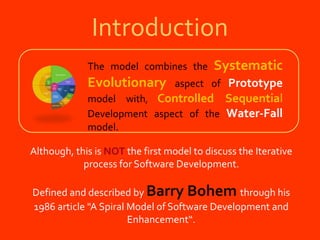Spiral model ppt
- 1. Spiral Model Shakthi Yasas Weerasinghe | 144188B Faculty of Information Technology University of Moratuwa
- 2. Introduction Although, this is NOT the first model to discuss the Iterative process for Software Development. Defined and described by Barry Bohem through his 1986 article "A Spiral Model of Software Development and Enhancement“. The model combines the Systematic Evolutionary aspect of Prototype model with, Controlled Sequential Development aspect of the Water-Fall model.
- 3. Abstract Typically, iterates for 6 months up to 2 years Has emphasis on Risk Analysis Each phase starts with a specific set of goals and ends with the customer giving back the feedback, reviewing the progress/prototypes delivered up to that point. Also called as Meta- Model as this is based on most of other SDLC methods. Four Phases : Planning, Risk Analysis, Engineering and Evaluation.
- 4. 1 Determine Requirements 2 Designing the System 4 Evaluation and Risk Analysis 3 Implementing the System Release Spiral Model Diagram
- 5. Spiral Model Stages Requirement Identification Starts with gathering business requirements in the Baseline. • Identifying System & Sub-System Requirements • Unit Requirements • Understanding the Design In the Baseline, Conceptual Designing is performed on all possible components. • Architectural Designs • Logical Designs of Modules • Physical Product Designs
- 6. Construct Proof of Concept is being created at the Baseline Spiral to get customer feedback. Production of actual Software System is performed at each Spiral Model Stages Evaluation At the Baseline Spiral, the customer evaluates the software and designs which prompts a feedback. Identifying, Estimating and Monitoring technical feasibilty, as well as the Project Management Risks (such as Schedule Slippages,
- 7. Usage of Spiral Model When Risk-Evaluation is Nessacary For Medium and Large Scale Software Project Development When the Customer is Not Sure about the Requirements When the Project is HIGHLY COMPLEX When Developers RequireClarifications during the SDLC When Significant Changes are expected during the Life cycle.
- 8. Advantages of Spiral Model Changes can be accommodated Allows extensive use of Prototypes Requirements can be captured more clearly & accurately Users see the system Clearly. Development can be divided into smaller parts and more risky parts can be developed earlier which helps better risk management.
- 9. Disadvantages of Spiral Model Management is more Complex The Process itself is Complex Large no. of Intermediate stages require excessive documentation Not suitable for small or low risk projects. End of the project is not known. In fact, the spiral can go iteratively until infinity or practically for years.
- 10. ThankYou !










